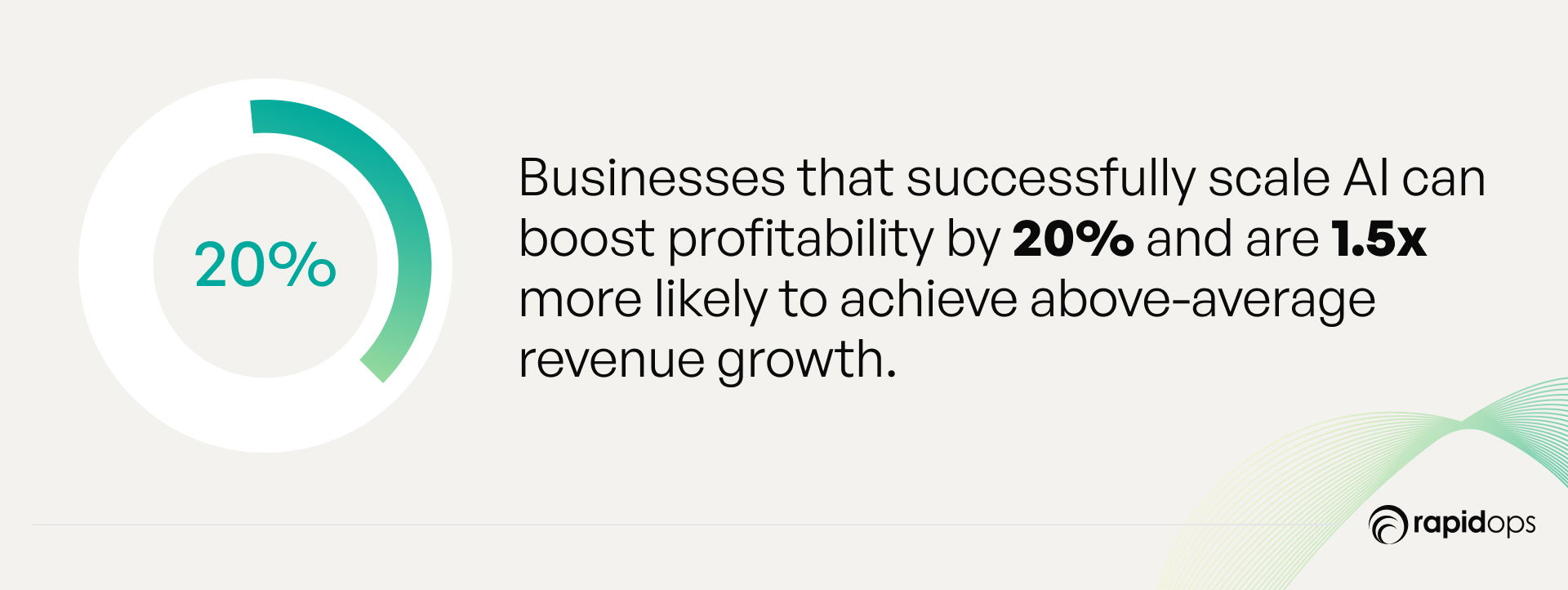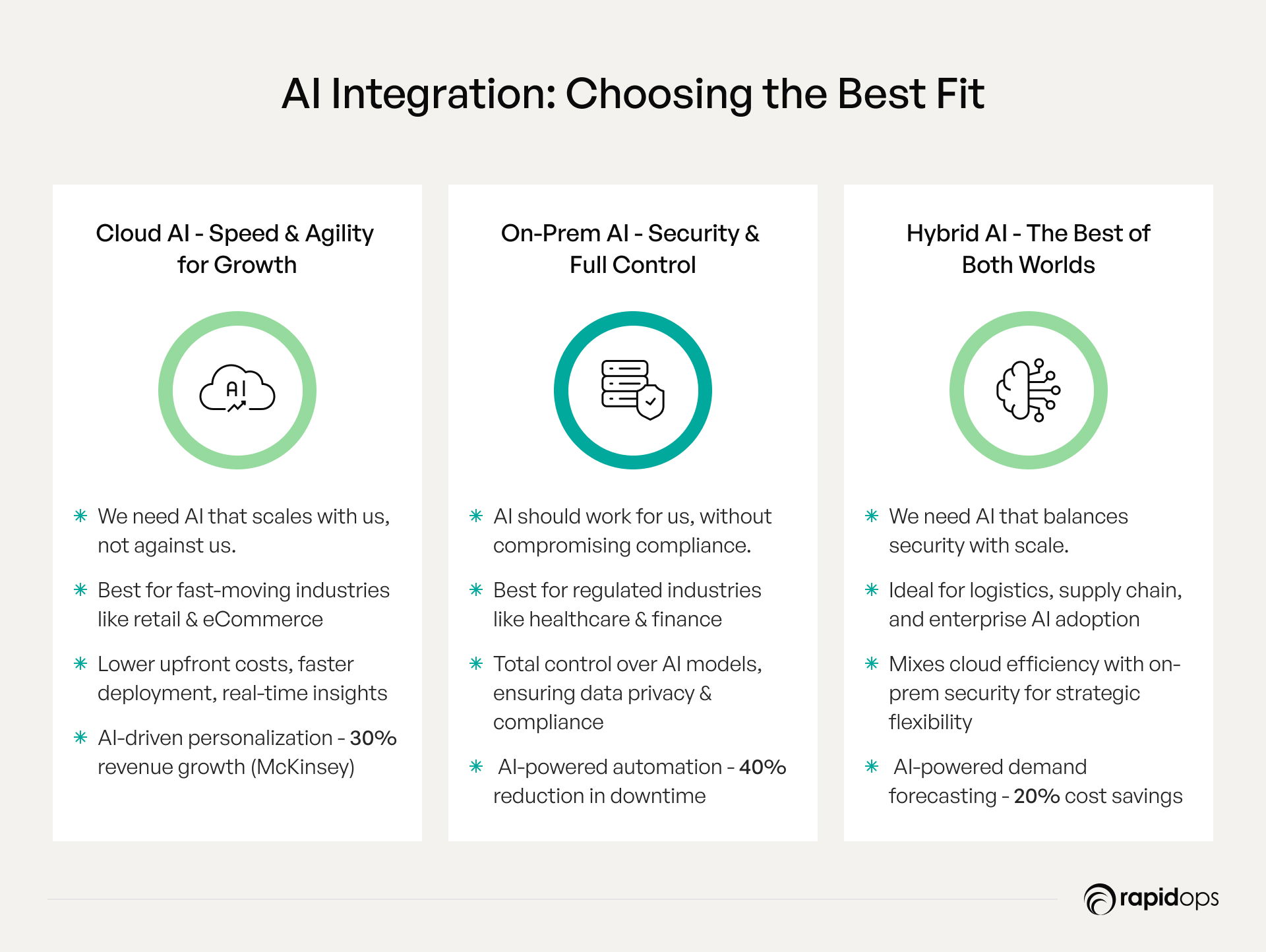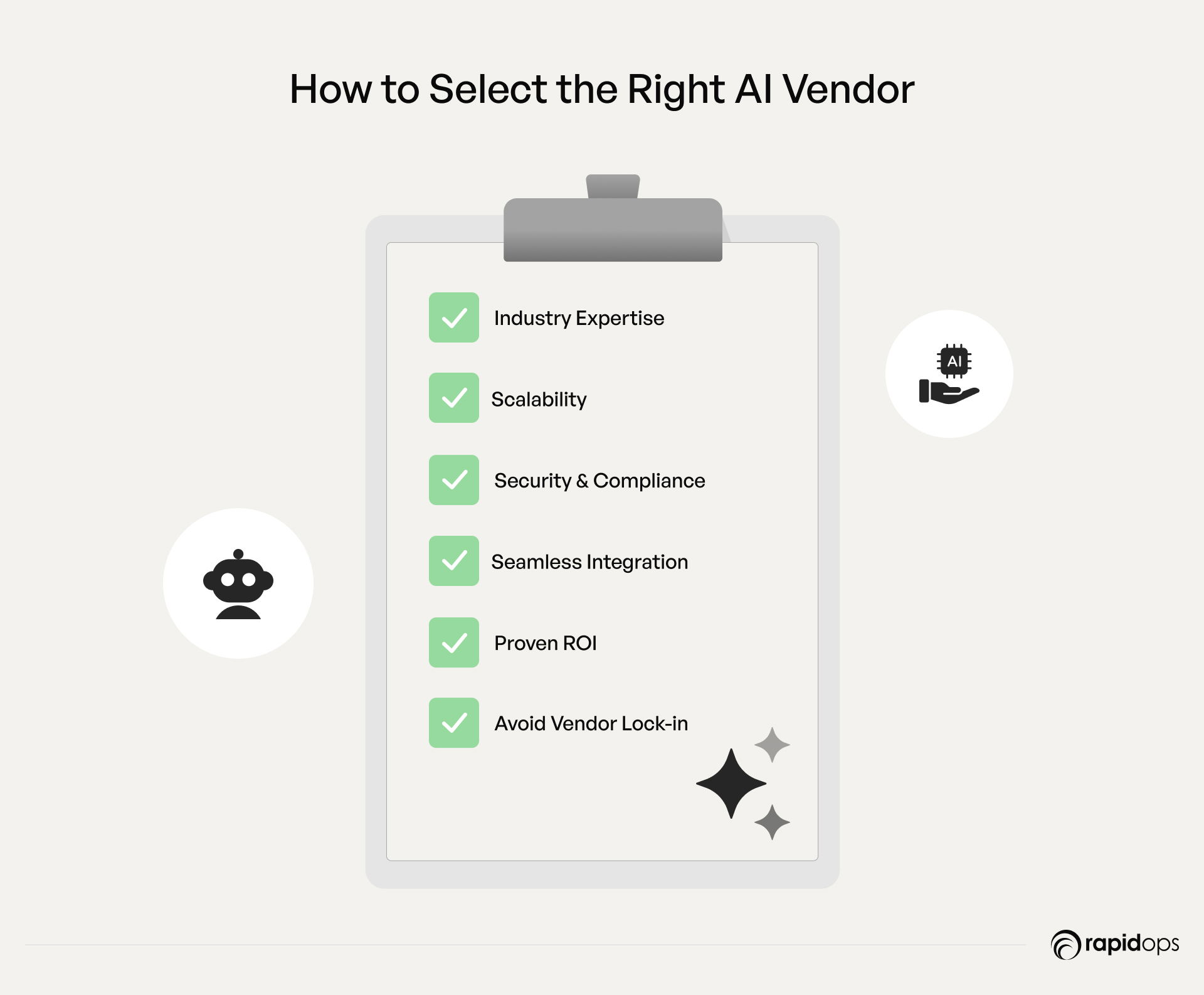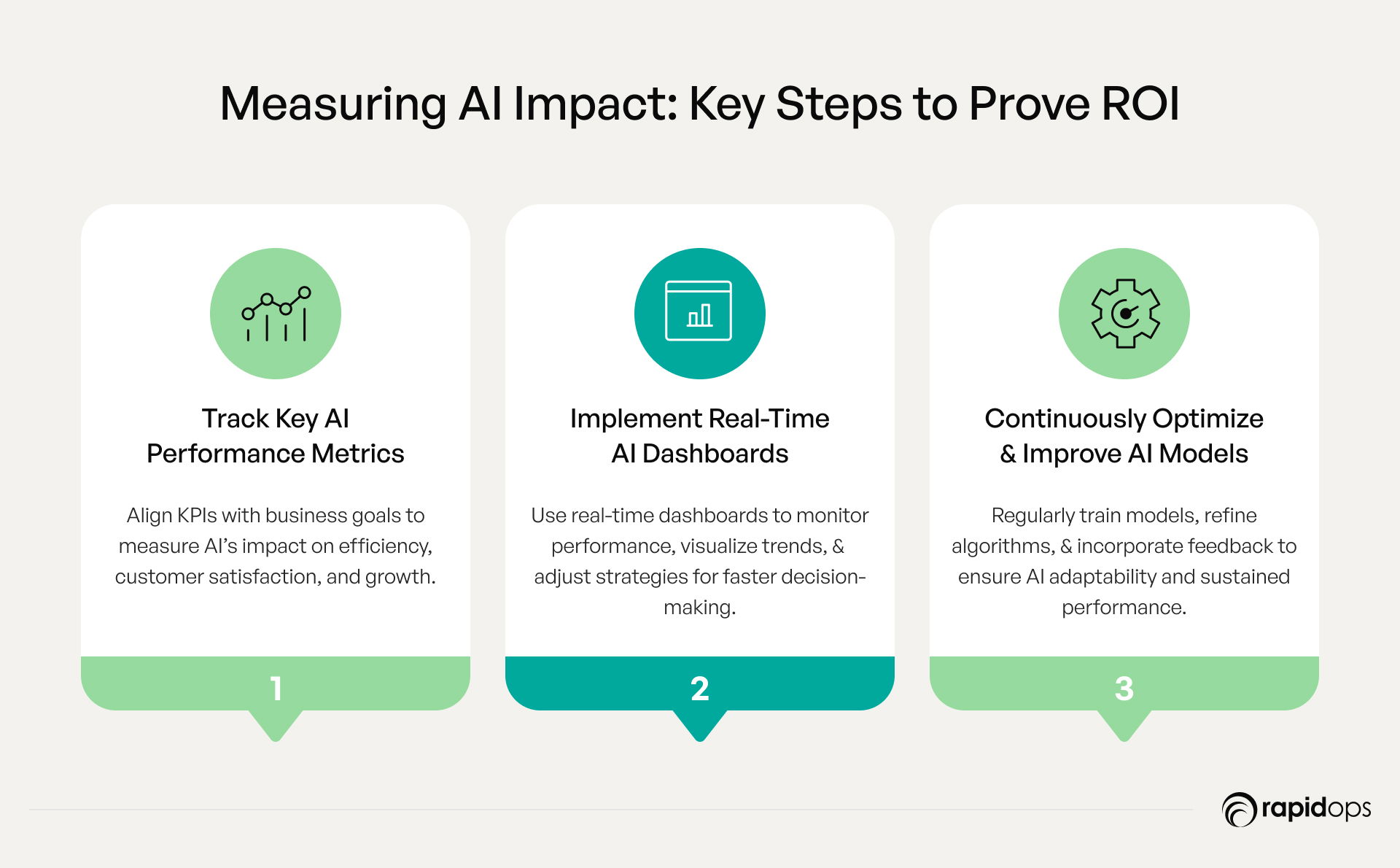AI can be a company’s greatest competitive advantage or a costly experiment that fails to scale. The difference? A strategic, enterprise-wide approach to integration.
Despite significant investments, 70% of AI projects fail (McKinsey), not due to technology but due to poor execution. Many companies treat AI as a one-off experiment rather than embedding it into core business strategy. At the same time, 85% of executives recognize AI’s potential, yet most struggle to generate measurable impact (PwC). This isn’t just a missed opportunity; it’s a competitive risk that needs to be addressed urgently.
The smartest companies don’t just adopt AI; they scale it. They align AI with business goals, invest in strong data foundations, and integrate intelligence into decision-making, operations, and customer engagement. Research shows that companies that successfully scale AI can increase profitability significantly, proving that AI, when done right, is a true growth engine.
This article explores the smart way to integrate AI into your business, turning AI from an isolated initiative into a scalable, revenue-driving advantage.

AI Integration: What It is, Why It Matters for Business Success
What is AI Integration?
AI integration is the process of embedding artificial intelligence into your core business operations, decision-making, and customer interactions. This approach transforms AI from being just a tool to becoming a vital part of your organization's ecosystem. AI integration enables systems to work together seamlessly across departments, creating a connected, intelligent environment that drives efficiency, innovation, and growth.
Unlike standalone AI tools that function in isolation, AI integration ensures that AI solutions, whether small or large work in harmony within your existing infrastructure. This cohesive approach allows real-time data flow, automation, predictive insights, and personalized experiences, helping your business operate smarter, faster, and more efficiently.
Key Aspects of AI Integration
- AI as a Business Enabler: AI as a Business Enabler: AI powers efficiency, sharpens decision-making, and fuels growth. It optimizes workflows, fosters innovation, and strengthens market positioning, becoming a fundamental force in business evolution and sustained competitive success.
- Seamless System Connectivity: AI integrates with your existing systems, breaking down silos and ensuring a smooth flow of data across departments. This connectivity provides actionable insights in real time, helping decision-makers act faster and more accurately.
- Adaptive Intelligence: AI continuously evolves by learning from new data, refining its predictions, and improving its recommendations. This adaptability ensures that businesses remain agile and responsive to changing market conditions and emerging opportunities.
Why AI Integration Matters for Business Success
Many organizations recognize AI's potential but struggle to unlock its full value. Without a structured and cohesive AI integration strategy, businesses often face inefficiencies, fragmented workflows, and missed opportunities.
A well-executed AI integration ensures that insights are actionable and impactful, enabling businesses to optimize operations, streamline supply chains, and deliver better customer experiences. When integrated properly, AI can lead to.
- Increased Agility: Businesses can respond more effectively to market changes and evolving customer demands.
- Improved Decision-Making: AI provides data-driven insights that enable better, faster decisions across all levels of the business.
- Enhanced Competitive Positioning: AI-powered systems streamline operations, giving businesses a competitive edge through smarter, more efficient workflows.
By seamlessly integrating AI into your business processes, your company can achieve sustainable growth, agility, and operational excellence, staying ahead of the competition and driving long-term success.
Assessing Your Business’s AI Readiness
AI adoption goes beyond technology, it requires strategic readiness. This framework helps assess gaps, data, infrastructure, and talent for seamless integration and success.
1. Identifying AI Gaps & Challenges
AI isn’t a one-size-fits-all solution. Different industries face unique challenges that AI can solve, but only if businesses pinpoint where AI delivers the most impact.
Key Industry Challenges & AI Solutions
Retail - Scaling Personalized Customer Experiences
- Challenge: Generic marketing efforts struggle to retain customers.
- AI Solution: AI-powered recommendation engines, sentiment analysis, and real-time dynamic pricing enhance personalization and engagement.
Manufacturing - Downtime & Inefficiencies in Production
- Challenge: Unplanned downtime and inefficient processes increase costs.
- AI Solution: Predictive maintenance and smart automation reduce downtime by up to 40% and optimize resource allocation. (Source: McKinsey)
Logistics - High Costs & Supply Chain Inefficiencies
- Challenge: Poor supply chain visibility and inefficient routing increase operational costs.
- AI Solution: Route optimization, demand forecasting, and automated inventory management improve efficiency and reduce delivery delays.
2. Preparing Your Data for AI
AI is only as effective as the quality of data it’s trained on. Poor or fragmented data leads to inaccurate AI predictions and inefficient outcomes.
AI-Readiness Data Checklist
- Is your data structured, clean, and labeled? Unstructured or incomplete data weakens AI models, consolidate, organize, and label datasets for accuracy.
- Have you audited data quality & consistency? AI models require unbiased, high-integrity data to produce meaningful insights. Regular audits ensure accuracy.
- Do you have data governance for security & compliance? AI must comply with data privacy laws (GDPR, CCPA) and follow cybersecurity best practices. Implement governance frameworks for responsible AI use.
Fact: Companies with structured, high-quality data see 30% more accurate AI insights than those with siloed or unstructured data. (Source: Gartner)
3. Assessing IT Infrastructure & Workforce Capabilities
AI requires scalable technology and skilled talent to deliver long-term value. Businesses must evaluate whether their IT infrastructure and workforce can support AI integration.
Infrastructure Readiness
- Do you have cloud computing & AI-compatible systems? AI workloads require high computational power & scalable storage, adopting cloud-based platforms (AWS, Google Cloud, Azure) ensures seamless AI deployment.
- Can your current IT systems scale with AI adoption? Legacy systems may not handle AI-driven automation & analytics. Ensuring compatibility avoids integration roadblocks.
AI Talent & Skills Readiness
- Does your workforce have AI literacy, or do you need external expertise? AI adoption requires data scientists, engineers, and domain experts to develop and manage AI models effectively.
- Have you developed an AI training roadmap? AI implementation isn't just about technology; it’s about people. Upskilling employees ensures they can collaborate with AI tools and leverage insights effectively.
Fact: Only 20% of businesses have the right AI talent in place, most struggle with skill gaps. (Source: PwC)
AI readiness is the first step. Prioritize high-impact applications, strengthen data, and invest in talent to turn AI into a competitive advantage.
Building a Winning AI Integration Strategy
AI adoption isn’t about chasing trends, it’s about unlocking real business value. But without a clear strategy, businesses risk wasted investments and fragmented AI initiatives.
To ensure AI delivers tangible business outcomes, leaders need a structured approach that aligns technology with strategic priorities. This three-step framework helps businesses transition from AI exploration to measurable impact, faster and more effectively.

Step 1: Identify AI Needs & Define Business Impact
Before investing in AI, organizations must ask the right questions:
- Where are the biggest bottlenecks? Is customer churn increasing? Are operations inefficient? AI should solve critical pain points, not just introduce automation for the sake of it.
- How does AI fit into broader business goals? Every AI initiative should align with a clear business outcome—whether it’s increasing revenue, reducing costs, or improving customer experience.
- What’s the fastest path to ROI? Not all AI projects yield quick results. Prioritizing high-impact, low-barrier use cases ensures early wins and stakeholder buy-in.
Defining AI’s Measurable Value
- Increase revenue per user by 25% with AI-driven personalized recommendations and dynamic pricing.
- Reduce operational downtime by 40% through AI-powered predictive maintenance.
- Lower supply chain costs by 20% using AI-driven demand forecasting and inventory management.
Fact: Companies that focus on well-defined AI goals see 2x faster ROI than those with vague initiatives. (Source: McKinsey)
Step 2: Prioritize High-Impact AI Use Cases & Assess Data Readiness
AI’s potential is limitless, but not every AI project is worth pursuing. The key is to focus on high-value use cases that align with business needs and have the right data foundation.
Where AI Delivers the Highest ROI
- Retail: Hyper-personalized customer experiences, fraud detection, and AI-driven pricing models.
- Manufacturing: Predictive maintenance to prevent costly breakdowns, AI-powered quality control, and process optimization.
- Logistics & Supply Chain: Route optimization for cost savings, warehouse automation, and AI-driven demand forecasting.
Fact: Businesses that focus on high-impact AI use cases experience 40% higher ROI within 12 months. (Source: PwC)
Step 3: Pilot, Test & Scale AI Solutions
AI success isn’t about one-time implementation, it’s about constant refinement. The best companies approach AI like an iterative experiment:
- Pilot AI with a small, focused initiative. Test AI models in one department before expanding across the organization.
- Measure, refine, and optimize. AI isn’t static, use continuous data feedback loops to improve performance.
- Scale based on real results. Expand only when AI has proven impact to avoid unnecessary costs.
Real-World Example
A global manufacturer piloted AI-driven predictive maintenance in one factory, leading to a 40% reduction in machine downtime within six months. After refining the model, they scaled it to 20+ facilities worldwide, achieving a 25% cost reduction in maintenance expenses.
Fact: Businesses that test AI in controlled pilots before full-scale adoption are 60% more likely to succeed. (Source: Gartner)
AI can be a game-changer, but only if businesses take a strategic, measured approach. The best companies don’t just adopt AI; they embed it into their DNA, making it a core driver of growth, efficiency, and competitive advantage.
Selecting the Right AI Tools & Vendors
After defining a strong AI integration strategy, the next step is making the right technology and vendor choices. Even the best strategy can fall short without the right tools and partners to execute it effectively. Selecting the right AI solutions ensures seamless adoption, cost efficiency, and measurable business impact—while the wrong choices can lead to integration failures, security risks, and scalability issues.
1. AI Integration Methods: Finding the Best Fit for Your Industry
The success of AI adoption depends on selecting the right deployment model based on security needs, scalability, and industry-specific requirements. Businesses must assess which model aligns with their long-term objectives.

a. Cloud-Based AI: Fast Deployment & Scalability
- Best for: Retail, eCommerce, customer-facing applications, and data-driven decision-making.
- Why it works: Cloud-based AI offers rapid deployment, lower upfront costs, and access to real-time AI analytics.
Key Use Cases
- AI-driven personalized recommendations 30% increase in revenue per user. (McKinsey)
- Demand forecasting to optimize inventory and reduce stockouts.
- AI-powered customer service automation with chatbots and virtual assistants.
If speed, cost-efficiency, and continuous AI innovation are priorities, cloud-based AI provides the fastest path to ROI without requiring heavy infrastructure investments.
b. On-Premises AI: Security, Compliance & Full Control
- Best for: Manufacturing, financial services, healthcare, and industries handling sensitive data.
- Why it works: On-prem AI ensures data security, full control over AI models, and compliance with strict regulations (GDPR, HIPAA, etc.).
Key Use Cases
Manufacturing: AI-powered automation for predictive maintenance and defect detection.
When data security, compliance, and control over AI infrastructure are critical, on-prem AI provides the reliability needed for regulated industries.
c. Hybrid AI: Balancing Security & Scalability
- Best for: Supply chain, logistics, and businesses managing sensitive yet scalable AI applications.
- Why it works: Hybrid AI combines cloud efficiency with on-prem security, offering a flexible approach for industries requiring both scalability and control.
Key Use Cases
- Supply Chain Optimization: AI-powered real-time inventory tracking, route optimization, and logistics automation.
- AI-Powered Compliance & Risk Management: Combining local data processing with cloud-based AI insights.
- Retail & Manufacturing: Running AI-powered demand forecasting while maintaining secure, on-prem control over sensitive business data.
Hybrid AI enables businesses to scale AI adoption while maintaining security and compliance, making it a strategic choice for industries requiring controlled flexibility.
2. Vendor Selection: Key Criteria for AI Success
Selecting the right AI vendor is not just about technology—it’s about long-term business impact. A vendor that lacks industry expertise, scalability, or compliance capabilities can become a major roadblock. Here’s what C-suite leaders should evaluate:

- Industry Expertise - Does the vendor have a proven track record in your sector?
- Scalability - Can the solution scale as AI adoption expands?
- Security & Compliance - Does it meet industry-specific regulatory requirements?
- Integration Flexibility - Can the AI system seamlessly integrate with your existing tech stack?
- Proven ROI - Does the vendor provide measurable success metrics and real-world case studies?
- Avoiding Vendor Lock-in - Does the vendor allow flexibility in AI tools and integrations to prevent dependency?
- Long-Term Partnership Potential - Does the vendor offer continuous innovation and support?
Fact: Companies that partner with AI vendors aligned to their industry needs see 2.5x faster AI adoption and impact. (PwC)
Aligning AI Selection with Business Goals
AI implementation is not just a technology decision, it’s a business strategy. Choosing the right AI tools and vendors will determine whether AI investments drive long-term success or become costly setbacks. Business leaders must ensure that their AI decisions:
- Align with core business objectives.
- Ensure security, compliance, and scalability.
- Deliver measurable business outcomes and competitive advantage.
By selecting the right integration approach and AI partners, businesses can future-proof their operations and maximize AI’s transformative potential.
Measuring AI Success & Proving ROI
To prove AI's ROI, measure its impact through key metrics like efficiency, revenue growth, and customer satisfaction. Align these outcomes with business goals to demonstrate AI’s real value and long-term success.

I. Track Key AI Performance Metrics
To measure AI’s success, businesses must align key performance metrics (KPIs) with their business goals. Industry-specific KPIs help track AI’s impact on operational efficiency, customer satisfaction, and bottom-line growth.
- Retail: Focus on customer engagement, retention rates, and revenue per user. AI-driven personalization can significantly increase revenue and repeat purchases by tailoring recommendations to individual customer preferences.
- Manufacturing: Track downtime reduction and cost savings from predictive maintenance. AI tools can predict machinery failures, allowing businesses to perform proactive maintenance and avoid unplanned downtime.
- Logistics: Measure on-time delivery rates and supply chain efficiency. AI-driven route optimization enhances delivery times and helps reduce transportation costs, ensuring timely deliveries and efficient operations.
Tracking these KPIs ensures that AI initiatives are directly contributing to business goals, proving their ROI and enabling further growth.
II. Implement Real-Time AI Dashboards
Real-time AI dashboards provide decision-makers with immediate access to key performance indicators (KPIs), allowing businesses to track AI impact and adjust strategies quickly.
Key Benefits
- Instant Insights: Monitor performance across AI applications, from customer experience to efficiency, in real time.
- Actionable Data: Visualized data highlights trends, gaps, and improvement opportunities.
- Informed Decisions: Adjust AI models or reallocate resources based on live data.
Real-time AI dashboards give decision-makers instant access to key performance metrics, enabling proactive strategy adjustments.
By visualizing data, businesses can track AI’s impact, identify trends, and optimize operations in real time. Companies using AI-powered dashboards see a 30% faster decision-making process by continuously monitoring and reacting to KPIs. (Source: Harvard Business Review)
III. Continuously Optimize & Improve AI Models
AI is a continuous journey, not a one-time implementation. To ensure sustained results, AI models must be regularly refined and updated.
Best Practices for Ongoing AI Optimization
- Regular Model Training: Continuously train AI models to keep them aligned with evolving data, trends, and customer behaviors.
- Real-Time Feedback Loops: Enable AI systems to learn from past performance, refine predictions, and adapt to new data.
- Refine Algorithms: Use performance metrics to adjust algorithms and data inputs for improved results.
Ongoing AI optimization enhances accuracy, speed, and adaptability. Companies prioritizing it see a 25% annual AI performance boost, enabling tools like chatbots to refine interactions and meet evolving market demands. (Source: Deloitte)
Navigating AI Integration Challenges: Key Roadblocks to Overcome
I. Data Integration & Compatibility Issues
AI systems rely heavily on clean, structured, and unified data. However, businesses often face significant obstacles with data integration, including.
- Fragmented Data: Data stored in isolated systems often hinders AI's ability to deliver meaningful insights. AI cannot efficiently process information across departments or systems without a centralized data structure.
- Poor Data Quality: Outdated or inconsistent data weakens AI's accuracy. Data quality is vital for AI to make informed predictions and generate actionable results.
- Integration with Legacy Systems: Legacy databases can impede AI integration due to compatibility issues. This often results in slow, costly implementations that delay AI adoption.
Solution: Businesses must prioritize data cleansing and integration strategies to create a unified, reliable data environment that supports AI-driven decisions.
II. Complexity in AI Integration with Existing IT Infrastructure
Integrating AI into existing systems like ERP and CRM platforms can be complex due to.
- Compatibility Issues: AI models may not easily integrate with legacy systems, often requiring expensive upgrades or full overhauls to accommodate modern AI solutions.
- Scalability Challenges: Many traditional IT infrastructures are not built to scale with AI. This makes expanding AI initiatives across departments and achieving full adoption difficult.
- High Costs & Time: Reconfiguring outdated IT ecosystems for AI is costly and time-consuming, leading to delays and increased resource investments.
Solution: A thorough IT infrastructure audit and phased AI implementation plan can ensure smooth integration without overwhelming existing systems.
III. Lack of Skilled Talent to Manage AI Implementation
AI integration demands skilled talent at every stage, from model training to performance monitoring. However, many businesses struggle with:
- Talent Shortage: A limited pool of skilled AI professionals delays deployment and leads to ineffective AI implementation.
- Over-reliance on External Vendors: Many organizations depend heavily on third-party vendors, resulting in increased costs and a lack of internal control.
- Lack of Internal AI Literacy: Employees may lack the knowledge and skills to leverage AI fully, reducing the effectiveness of AI tools in daily operations.
Solution: Companies should invest in AI talent development programs and upskill existing teams to foster a self-sustaining AI ecosystem within the organization.
IV. Resistance from Internal Teams During AI Implementation
Even after AI is deployed, businesses often face resistance from internal teams due to.
- Fear of Job Displacement: Employees may resist AI adoption due to concerns about automation replacing their roles, leading to reluctance to adopt new workflows.
- Lack of Trust in AI Insights: Many people hesitate to trust AI-generated recommendations, slowing down decision-making processes and reducing AI's effectiveness.
- Challenges in Workflow Transition: Teams accustomed to traditional methods may struggle to adapt to AI-enhanced processes, leading to inefficiencies and frustration.
Solution: Creating a culture of AI adoption through training programs, transparent communication, and demonstrating AI's value in augmenting human roles can help reduce resistance and increase engagement.
V. High Costs & Uncertain ROI During Initial AI Rollout
AI integration typically involves substantial upfront investments in software, infrastructure, and training, leading to several challenges.
- Unclear Financial Benefits: Many businesses struggle to quantify AI's ROI in the short term, making it difficult to justify large initial investments.
- Overinvestment in AI Solutions: Some businesses purchase AI tools without considering their scalability or long-term applicability, wasting resources.
- Difficulty in Measuring Impact: Without clear metrics, businesses may struggle to measure AI's impact, creating uncertainty about further investment.
Solution: Establishing clear AI goals, conducting pilot projects, and using performance metrics to measure success early on can help demonstrate AI's value and justify ongoing investment.
Businesses can align strategies with goals by addressing AI integration challenges, ensuring scalable, sustainable success and long-term value.
Take the First Step Toward AI Integration
AI integration isn’t a one-time leap, it’s a structured journey that adds value step by step. By adopting a strategic, scalable, and ethical approach, businesses can unlock new growth opportunities, enhance decision-making, and drive efficiency while staying true to their core values.
As you explore the possibilities AI offers, assessing your organization’s readiness and pinpointing areas where AI can have the most impact is crucial. At Rapidops, we’ve guided many businesses through this journey, helping them move from curiosity to fully integrated AI solutions. Our experienced team works alongside you, providing insights and solutions tailored to your industry’s specific needs.
What’s Next:
Taking the first step toward AI integration can feel like a big move, but you don’t have to navigate it alone. If you're exploring AI’s potential but unsure where to begin, our experts can provide clarity. Schedule a strategy session with us to discuss your goals, evaluate opportunities, and map out a strategic approach tailored to your business needs. Start a conversation and build a roadmap for AI success.

Rahul Chaudhary
Content Writer
With 5 years of experience in AI, software, and digital transformation, I’m passionate about making complex concepts easy to understand and apply. I create content that speaks to business leaders, offering practical, data-driven solutions that help you tackle real challenges and make informed decisions that drive growth.
What’s Inside
- AI Integration: What It is, Why It Matters for Business Success
- Assessing Your Business’s AI Readiness
- Building a Winning AI Integration Strategy
- Selecting the Right AI Tools & Vendors
- Measuring AI Success & Proving ROI
- Navigating AI Integration Challenges: Key Roadblocks to Overcome
- Take the First Step Toward AI Integration

Let’s build the next big thing!
Share your ideas and vision with us to explore your digital opportunities
Similar Stories
- AI
- 4 Mins
- September 2022

- AI
- 9 Mins
- January 2023


Receive articles like this in your mailbox
Sign up to get weekly insights & inspiration in your inbox.

